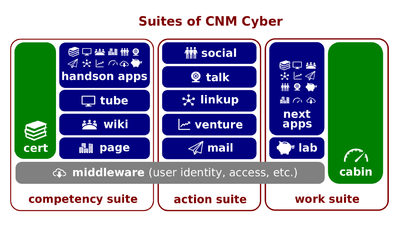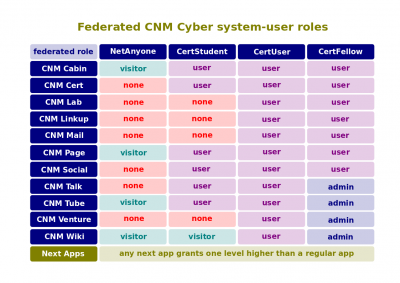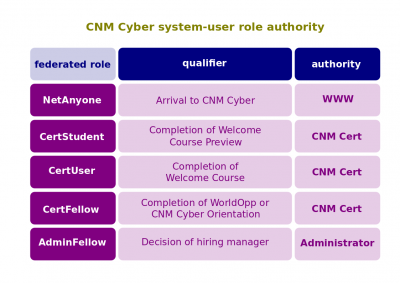Difference between revisions of "System-User Roles"
(→Script) |
|||
| (40 intermediate revisions by 2 users not shown) | |||
| Line 1: | Line 1: | ||
| − | [[File:Cnm-digital.png|400px|thumb|right|[[ | + | [[File:Cnm-digital.png|400px|thumb|right|[[CNMCyber suite]]s]][[System-User Roles]] (hereinafter, the ''Lectio'') is the [[lectio|lesson part]] of the '''[[Middleware Essentials]]''' [[lesson]] that introduces its participants to [[CNM Cabin]]. This ''lesson'' belongs to the [[Introduction to CNM Cloud]] session of [[EmployableU Concepts]]. |
==Content== | ==Content== | ||
| − | The predecessor [[lectio]] is [[ | + | The predecessor [[lectio]] is [[User Identities at Cloud]]. |
| + | [[File:Opplet-role.png|400px|thumb|right|[[Opplet role]]]][[File:Role-trigger.png|400px|thumb|right|[[Opplet role]]]] | ||
| + | |||
| + | ===Script=== | ||
| + | :[[WorldOpp Middleware]] controls your access to various resources such as applications, networks, and services. You have started here, at [[CNMCyber]], as a newbie with minimal rights. The more you learn here, the more system access permissions the ''Middleware'' grants. | ||
| + | |||
| + | :To accomplish that task, the ''Middleware'' assigns every user with his or her [[system-user role]]. For instance, any user of the [[World Wide Web]] has [[NetAnyone]]'s rights at [[Opplet]]. He or she can view pages of [[CNM Page]], [[CNM Tube]], and [[CNM Wiki]], but cannot edit anything. [[CertStudent]]s are enrolled into this very welcome course, as well as can post comments on [[CNM Page]] and [[CNM Tube]]. [[CertUser]] can join communities at [[CNMCyber.com]], and so on. To get the [[CertUser]] ''role'', one has to successfully pass [[EmployableU Concepts]]. | ||
| + | |||
| + | :Some permissions such as appointing other administrators and alternating the algorithms must be done manually. The bulk of user permissions at [[Opplet]] are granted automatically. In [[cyber-security]], user management operations are called [[identity and access management]] ([[identity and access management|IAM]]). | ||
===Key terms=== | ===Key terms=== | ||
| − | : | + | :[[System-user role]], [[NetAnyone]], [[CertStudent]], [[CertUser]], [[CertFellow]], [[identity and access management]] ([[IAM]]) |
| − | |||
| − | |||
| − | |||
| − | |||
| − | === | + | ===Closing=== |
| − | : | + | :Would you be interested in working on [[identity and access management]] ([[identity and access management|IAM]]) at [[CNMCyber]]? --Yes/No/I'd like to explore other options too |
| − | + | '''[[Federated vs Local Roles]]''' is the successor [[lectio]]. | |
| − | + | ==Questions== | |
| − | == | + | ===Placement entrance exam=== |
Latest revision as of 14:14, 13 April 2024
System-User Roles (hereinafter, the Lectio) is the lesson part of the Middleware Essentials lesson that introduces its participants to CNM Cabin. This lesson belongs to the Introduction to CNM Cloud session of EmployableU Concepts.
Content
The predecessor lectio is User Identities at Cloud.
Script
- WorldOpp Middleware controls your access to various resources such as applications, networks, and services. You have started here, at CNMCyber, as a newbie with minimal rights. The more you learn here, the more system access permissions the Middleware grants.
- To accomplish that task, the Middleware assigns every user with his or her system-user role. For instance, any user of the World Wide Web has NetAnyone's rights at Opplet. He or she can view pages of CNM Page, CNM Tube, and CNM Wiki, but cannot edit anything. CertStudents are enrolled into this very welcome course, as well as can post comments on CNM Page and CNM Tube. CertUser can join communities at CNMCyber.com, and so on. To get the CertUser role, one has to successfully pass EmployableU Concepts.
- Some permissions such as appointing other administrators and alternating the algorithms must be done manually. The bulk of user permissions at Opplet are granted automatically. In cyber-security, user management operations are called identity and access management (IAM).
Key terms
- System-user role, NetAnyone, CertStudent, CertUser, CertFellow, identity and access management (IAM)
Closing
- Would you be interested in working on identity and access management (IAM) at CNMCyber? --Yes/No/I'd like to explore other options too
Federated vs Local Roles is the successor lectio.


